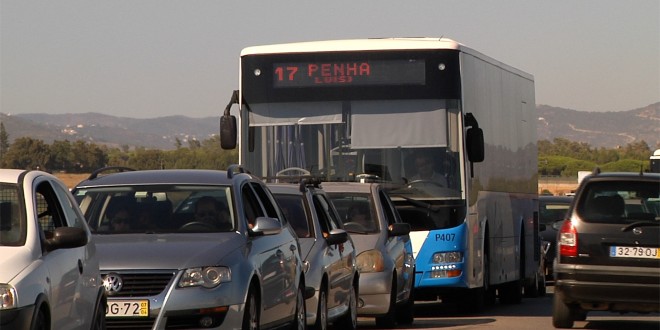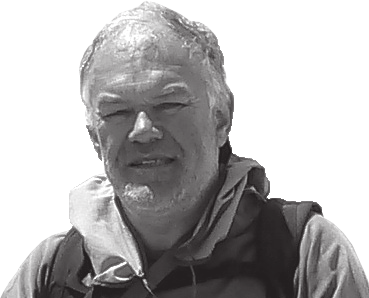A Test by Uwe Heitkamp
Waiting for the bus. I count the passing cars; one/one, two/one, three/one, four/one, five/one, six/one, seven/one, eight/one, nine/one, ten/one, eleven/one, twelve/two. That was it, the first car with two people inside.
We are all part of the daily traffic jam.
 I walk 1.1 km to the nearest bus stop. On the way there, my neighbour asks me why I’m walking? Has your car broken down? No, no, I answered, I’m leaving my car in the garage for a month. She looks at me sceptically, while she waters the flowers in front of her house with a hose pipe. My neighbours have got a weakness for cars. Her husband has a workshop in the village eight kilometres away. My neighbours, a household of three, with five cars.
I walk 1.1 km to the nearest bus stop. On the way there, my neighbour asks me why I’m walking? Has your car broken down? No, no, I answered, I’m leaving my car in the garage for a month. She looks at me sceptically, while she waters the flowers in front of her house with a hose pipe. My neighbours have got a weakness for cars. Her husband has a workshop in the village eight kilometres away. My neighbours, a household of three, with five cars.
As a foreigner, I am granted a little leeway in such ideas. People like that are allowed to walk in the heat of the summer. If that’s what they feel like…
Along with a water bottle, I carry a small notebook in my rucksack. I make a note of everything that happens, jot down words and sentences to record everything that’s going on around me throughout the summer. After all, people are forgetful.
The notebook is also intended to provide me with some answers to some existential questions. How exactly can a person change their behaviour in order to become climate neutral? Can I contribute to the process of using fewer raw materials, to emitting less carbon dioxide, to leaving less rubbish behind me?
I take a first, small step in the direction of giving things up. During the summer, the roads in the Algarve are so full that it drives you mad. We are all part of the daily traffic jam. So, why not leave the car at home for a month and go by bus?
Friday, 18th July.
 At the bus stop. I keep looking at the piece of paper I have printed, the Frota Azul bus company’s timetable. I check to see if a bus really will stop here at the scheduled time. Because there is no customer information of any kind on the bus stop itself. For a month, I am going to set myself the challenge of only travelling by bus and train, and using my bike and my own two feet. I get a 7-day ticket worth €36.50 sponsored by EVA that allows me to travel on all the bus routes run by this regional bus company.
At the bus stop. I keep looking at the piece of paper I have printed, the Frota Azul bus company’s timetable. I check to see if a bus really will stop here at the scheduled time. Because there is no customer information of any kind on the bus stop itself. For a month, I am going to set myself the challenge of only travelling by bus and train, and using my bike and my own two feet. I get a 7-day ticket worth €36.50 sponsored by EVA that allows me to travel on all the bus routes run by this regional bus company.
At last, it comes around the corner and stops at a place on the other side of the road where no bus stop is shown. The traffic builds up behind the bus. On the bus, which has room for 48 passengers sitting and 18 standing, there are already 15 people, and another nine get on during the trip. I had obtained information about the emissions of the different buses and get my climate calculator out of my rucksack: the bus emits 280 grams of CO2 for every kilometre it travels. Twenty-four passengers travel 20 km on the trip from Caldas de Monchique to Portimão. Result: only 233 grams of CO2 emitted per passenger.
If I had used my own car (1200 cc, 65 horsepower, petrol, 160 grams of CO2 per km), I would have emitted 3.2 kilos of CO2.
On the return journey, there are only 13 passengers on the bus: 430 grams of CO2 emitted per passenger. What could make bus travel in Portugal more attractive, what might motivate people to leave their cars behind, or even better, to stop using them altogether and change to bus and train?
Sunday, 20th July.
Today I’m planning a longer trip. I travel to Portimão on the Sunday bus at 10 o’clock, change and then continue to Faro. For a distance of less than 100 km, I’ll be travelling for exactly three hours and fifteen minutes. Possibly a record?
For a distance of less than 100 km, I’ll be travelling for exactly three hours and fifteen minutes. Possibly a record?
There are eight passengers on the bus, five people of pensionable age, and a young couple from Scandinavia. After me, two more, older women get on. We drive the 20 km to Portimão in a fairly old Mercedes bus. Each of us is responsible for the emission of 560 grams of CO2 for the 20 km we have travelled. In my car, I would emit six times that quantity of greenhouse gases, but be there twice as fast. Why is speed so important for us, what do we really get from it at the end of the day?
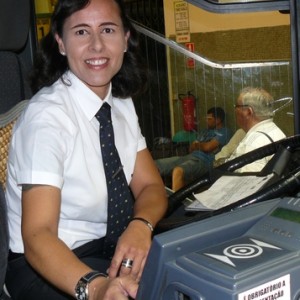
Every Sunday at 11 a.m., the “Interurbano” leaves Portimão for Faro. I could also get to Faro by train, but prefer to go by bus on the outward journey. The bus driver Maria José Batista is one of the very few women in a male-dominated workforce. After passing through the villages of Mexilhoeira da Carregação, Estombar, Lagoa, Porches, Armação da Pêra and Alcantarilha, she has to put all her skill to the test as she turns into the narrow village street of Pêra where not even two cars would be able to squeeze past each other. And now she forces her old Setra bus along the narrow lane and hoots back at oncoming cars. Waving her arms out wide, she shoos drivers into the side streets or makes them reverse until she has manoeuvred her own 12-metre vehicle through. Past the Albufeira marina and up the narrow lanes, we reach the main bus station. Bathroom break.
The ranks thin. There are now only 12 passengers in the bus’s 48 seats as far as Loulé. From Loulé, we’re down to just nine paying passengers. When I ask at the terminus exactly how many kilometres the bus has covered between Portimão and Faro, Maria José Batista replies that it was 89 km. So, out comes the climate calculator to work out 89 km journey x 280 grams of CO2 per km travelled: an average of 12 passengers, makes 2.077 kg CO2 per passenger…
For the return trip, I choose the 16.17 train from Faro to Portimão. It is not as slow. According to the rail company CP’s simulator, I am responsible for 1.02 kg CO2 over 60 km. The ticket costs six euros. Once again, I wait for the connecting bus from Portimão to Monchique, this time a whole hour. At 18.30, I’m on my way again at last. 20 km trip x 280 grams of CO2 per km travelled: an average of 16 passengers = 350 g CO2 per passenger.
Total CO2 emissions for the day: 4.007 kg. By car, I would have emitted 26.88 kg of CO2 and spent 21 euros on petrol. Does anyone actually think about their personal CO2 output when they get into their car?
Money is time.
People who travel by bus, by bike or with their friends and often leave their car behind or increasingly share their own with friends and neighbours emit a sensationally small amount of CO2 and leave a very small ecological footprint. But people who sit alone in their cars and use them in their region for shopping, driving around, for outings and for getting to and from work, are not only living incorrectly in ecological terms, but also uneconomically. Driving a car is an expensive business, from all points of view. I took the time to work it out when I was travelling by bus. (see box) Driving may make everything easier and reduces the amount of time things take. But if I travel by bus or train, I really slow down, I decelerate, live much less stressfully and gain a lot of time e.g. for thinking. Walking or cycling more is purely a matter of habit. Will power counts, and where there’s a will there’s a way. The day is getting closer and closer when the era of individual car driving, when mobility itself will become nothing less than a question about the meaning of life.

Tuesday, 5th August.
The working day of a journalist. At 7.30, I leave home on foot, heading for the bus stop. At 8.15, the bus stops in Caldas on its way from Monchique, and carries me to Portimão. 18 passengers. I haven’t had my free travel ticket extended. I would like to know how much a ticket costs? €4.20. Arrival in Portimão at 8.45. At the station, I buy a ticket to the railway station Livramento 80 kilometres away. Price: €7.75.
At 9.19, I set off on the journey towards Faro and Tavira in a train dating from the 1970s. The window through which I look to the outside is so old that everything appears milky and blurred. Scratched, or just dirty? The carriages are old and the train’s suspension seems to be broken. On every curve, the carriages give a loud crack. Is there an MOT for trains? Arrival in Livramento at 11.09.
I visit an agricultural business that grows tropical fruit on several hectares. I’m doing research for a short report and an interview.
14.16. Return journey towards Portimão heading west. Travellers buy their tickets to Portimão from the ticket collector on the train. The railway company has cut all ticket offices and clerks at smaller stations. A one hour twenty minute wait in Faro. At 16.17, onward journey to Portimão, arrival at 17.30. A one-hour wait for the next bus to Monchique. I pay another €4.20 and travel up into the hills with 14 other passengers. I press the stop button before the bus stop but the driver is engrossed in conversation with a woman passenger. I have to call him loudly. He brakes hard. Inattention must be the biggest problem among bus drivers. Time and again, there are passengers who are simply left standing at a bus stop, who get forgotten. I am surprised that there are still so many people travelling by bus at all. I get home again at 19.30.
I’ve been travelling for 12 hours.
Summary:
For four weeks, from 15th July till 11th August, I travelled by bus and train, and much more often by bicycle. Ultimately, what I discovered about myself was that I often simply stayed at home more, where otherwise I would have quickly done something by car. I only became mobile when it was really necessary.
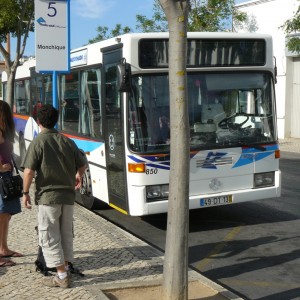
But there is much that could be done to improve public transport in the Algarve. A bus company that puts no information about departure times for clients on its bus stops shouldn’t be surprised that it gets no new customers. The buses drive 80% empty through the countryside. It is the basis of every business concept that clients should be given as much information as possible. That starts with putting a timetable on all bus stops and ends with a completely fair, transparent and comprehensible price and discount policy for all passengers. None of the bus drivers told me during the test that I would get a 33% discount with the blue Frota-Azul card if I bought at least five tickets in advance. And how many new customers might be attracted by a monthly ticket valid for all routes in the Algarve? It was simply too time-consuming for me to have to reload a free weekly ticket every Friday in Portimão. The effort does not justify the resources used.
One father told me that, for over a year, his family had always paid the full €4.30 fare between Monchique and Portimão, before he himself became actively involved and obtained information about discounts; and about discounts for children between the ages of four and nine, who had always paid the full fare until then.
A ticket for a 25 km bus journey from Monchique to Portimão costs €4.30. An 18 km journey from Caldas de Monchique to Portimão costs 20 cêntimos less, in other words €4.10. Meanwhile, a 7 km trip from Caldas to Monchique still costs €2.25. Do you notice anything?
I ask the Sunday bus driver, who was driving a 48-seater bus with eight passengers on board, why he didn’t take a smaller bus from the depot. Shrug of the shoulders. Consumption of 32 litres of diesel for every 100 km covered. More internal flexibility would certainly not go amiss here, for both economic and ecological reasons. Let’s assume the following: the bus company EVA – Frota Azul would actively promote its buses and discounts, e.g. at its own bus stops. They own hundreds of them. Would they then have more clients, better use of capacity, higher annual profits and more of their own funds to make major investments, e.g. to purchase a dozen new e-buses?
The managers of EVA – Frota Azul cannot be indifferent to the fact that they are withholding information and are making do with customers who have no other choice – pensioners, school children, commuters, and the socially weak, who cannot afford a car, or ecologically aware customers who do not want to afford a car! Of course, these groups make up a minority. Twenty percent use of capacity is a joke. For example, in order to occupy half of the seats, public transport would have to take centre stage in society, and try out new strategies to find new target groups there (customers!), and they would certainly find them there as well. But that will only happen with staff who are creative and alert, who think actively and are highly motivated. Do we have people like that here?
Buses and trains also need to get a bit faster, of course. Double-track, electrified railways in the Algarve would already be a big step towards the level of the rest of Europe. After all, you orientate yourself upwards rather than downwards, don’t you? As a matter of principle, buses, taxis and electric cars should have their own lane on main roads so that they can avoid the summer’s catastrophic traffic jams. And EVA – Frota Azul’s fleet also needs modernising and fewer different makes. This would create synergies.
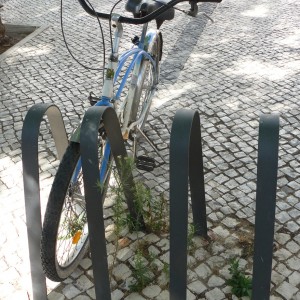 While we’re on the subject of mobility, we shouldn’t forget either cyclists or pedestrians. They too need their place in the mobility plan. We need cycle tracks and footpaths into the towns, and out again! We need secure parking places for bicycles.
While we’re on the subject of mobility, we shouldn’t forget either cyclists or pedestrians. They too need their place in the mobility plan. We need cycle tracks and footpaths into the towns, and out again! We need secure parking places for bicycles.
At present, cars are given absolute priority. But in 90% of cases, they are only carrying one person, the driver. What a waste of resources! If we want to make our economy more efficient, we should distribute our resources better and share them with each other, and break down our daily selfishness. Our country can’t afford to disadvantage buses and trains in the mobility plan; on the contrary, everyone in the country should have the will and greater interest in investing more time, more work, more energy, more patience, and much more money in the public transport network. Where there’s a will there’s a way. In some cities in northern Europe, many buses pick their customers up from their houses and take them home again. Small buses, mind you. Wouldn’t it be better for our words to be followed by concrete deeds?
A Calculation.
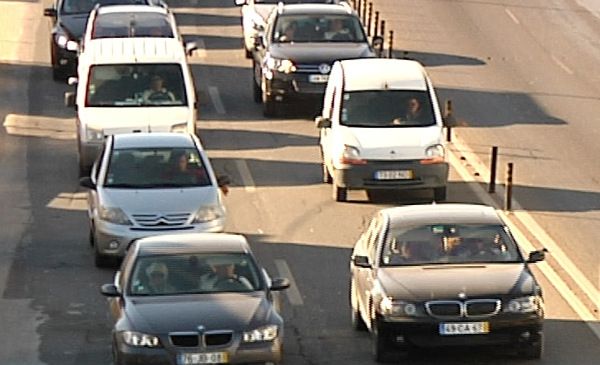
Anyone born in 1960 or later has spent their whole adult life with their cars; often more time with and in their cars than with their actual partner or their children. The overwhelming majority of adults today have watched as trees have been felled to build roads; as fields have been turned into motorways, and as their nearest and dearest have gone to hospital, the victims of road accidents. But the obsession with cars has not been affected, and nothing has changed in people’s mobility behaviour. What is there actually in favour of pursuing the car as a dream of freedom? Efficiency? Saving time? Is driving cheaper?
People who wonder about purchasing a car are in most cases not at all clear about the true costs of their car. Many people associate the running costs for fuel, oil and caring for one’s car with the total costs of a car. But that is wrong. You must add to this the depreciation which depends on mileage, possibly the costs and interest for a loan, workshop costs for inspections, repairs and new tyres, and fixed costs such as taxes, insurance, parking fees and possibly garage rental. If a car covers 10,000 km a year, in the case of a Renault Clio 1.5 dCi Energy 90 horsepower, purchase price 18,900 euros new, it costs exactly 5,352 euros (446 euros per month); if the car covers 20,000 km this increases to 6,682 euros or 557 euros a month. Motorway tolls, and environmental and health costs are not even included. It is a fact that, if you buy a car new, you will spend about the same on running it in the first four years as the car cost in the first place.*

Motorway tolls €0.08 per km
If you consider not only the economic costs, but would like to calculate the true cost of one kilometre of driving, you have to put a price on external effects like pollution, noise etc. Nowadays, many of the accident and environmental costs (noise, air pollutants), but also investments in infrastructure (building and maintenance of traffic systems) are paid for by the community as a whole. These costs that are not paid for by those who cause them are referred to as external traffic costs. These costs that are borne by the general public are not included in the price for travelling that individual road users have to pay, and hence are not taken into consideration when individuals decide how to travel. According to a current calculation by the company BRISA, the toll for cars on local motorways is approximately eight euros per 100 km. On the basis on one kilometre of motorway, this would add another eight cents.
CO2 emission charges of €18.40 per 10,000 km
But the costs of CO2 output would not be included in such a toll. In 2013, emission rights for the output of one tonne of CO2 (1,000 kg) cost €14.26 on the Spot Market for EU Emission Allowances, a ridiculously low price for the damage that CO2 causes in the atmosphere. In our version, according to the official car documents, a Renault Clio emits 129 g/CO2 per km. For every 10,000 kilometres travelled, there are additional costs of €18.40.
Loan and interest costs €0.127 (€0.25) pro km
Knowing well that banks in Portugal charge the highest interest on loans and pay the lowest interest on deposits in the euro zone, ECO123 selected a bank in a different euro country. Every Portuguese citizen has the unrestricted right to open an account in the 18 euro zone countries, to deposit their money there and request loans.
If we wanted to buy the whole car on credit and wished to pay off a loan of 20,000 euros in 48 months, we would have to pay an average of 6% interest (in Portugal an average of 11.9%). With a monthly instalment of 470 euros (in Portugal €573), financing costs totalling 2,546 euros would accrue (in Portugal €7,504).
As a consequence, with an annual kilometrage of 20,000 km, the costs of running a car go up by 0.127 euros per km. With an annual kilometrage of 10,000 km, the costs of running a car go up by 0.25 euros per km.
Owing to the fact that we were not obliged to purchase a car with the €20,000, but could have invested the money on the capital market, we also have to calculate the lost interest. This is the interest that would have been earned if the capital had been invested on the capital market instead of being used for purchasing a car. At an interest rate of 4%, within ten years the interest would amount to €8,000 or €67 per month: a sum which you could easily use to buy half a bus ticket…
For a 100 km long car journey, the cost including credit/interest costs amounts to €66 with an annual kilometrage of 20,000, and as much as €87 with an annual kilometrage of 10,000 km per year.
One example, two figures, three comparisons
According to Google Maps, a trip from Faro to Lisbon Gare-Oriente is exactly 274 km long.
- In a Renault Clio, the trip would cost €180.84 with an annual kilometrage of 20,000 km, or €238.38 in the case of an annual kilometrage of 10,000 km. 35.35 kg of CO2 are emitted over 274 km.
- On a flight in an Airbus A 320 from Faro to Lisbon in economy class and a trip of 274 km at a height of 6,800 m, a passenger emits 60 kg of CO2. Costs of a TAP ticket: €139.90.
- In contrast, a rail journey with the Alfa Pendular (2nd class) costs only €22.20 with 6.47 kg of CO2 – on the Intercity, €21.20 with emissions of 5.65 kg of CO2.
Any more questions?

 Eco123 Revista da Economia e Ecologia
Eco123 Revista da Economia e Ecologia

